A cicada stamp from South Korea. I think it’s a species of Platypleura.
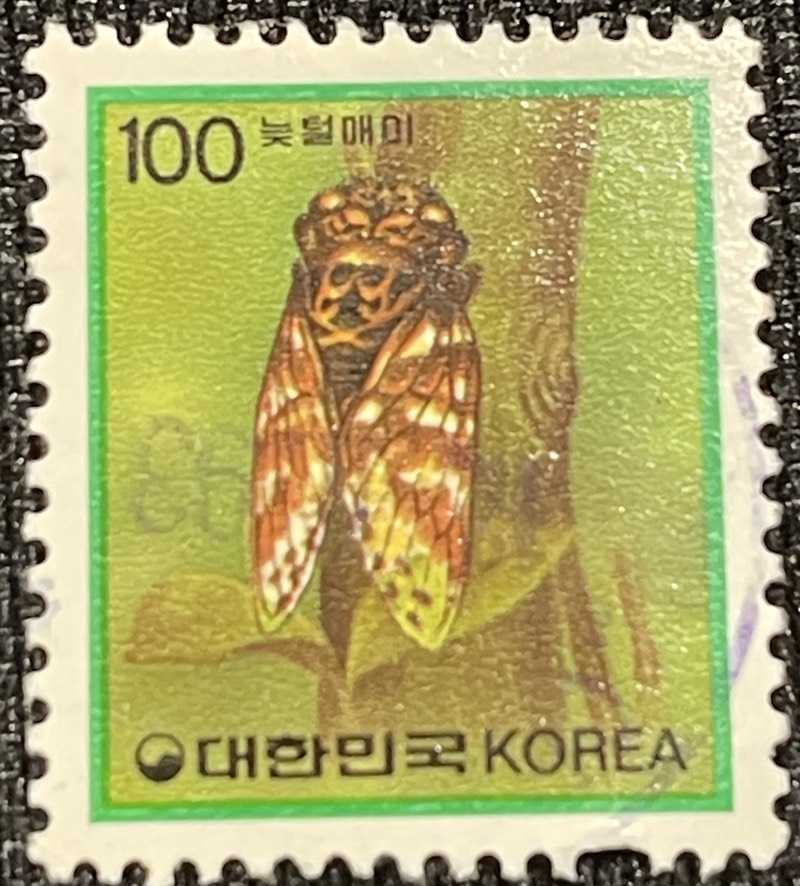
A cicada stamp from South Korea. I think it’s a species of Platypleura.

Female Cryptotympana atrata photo by Jon Allen from 2006. Taken in South Korea.
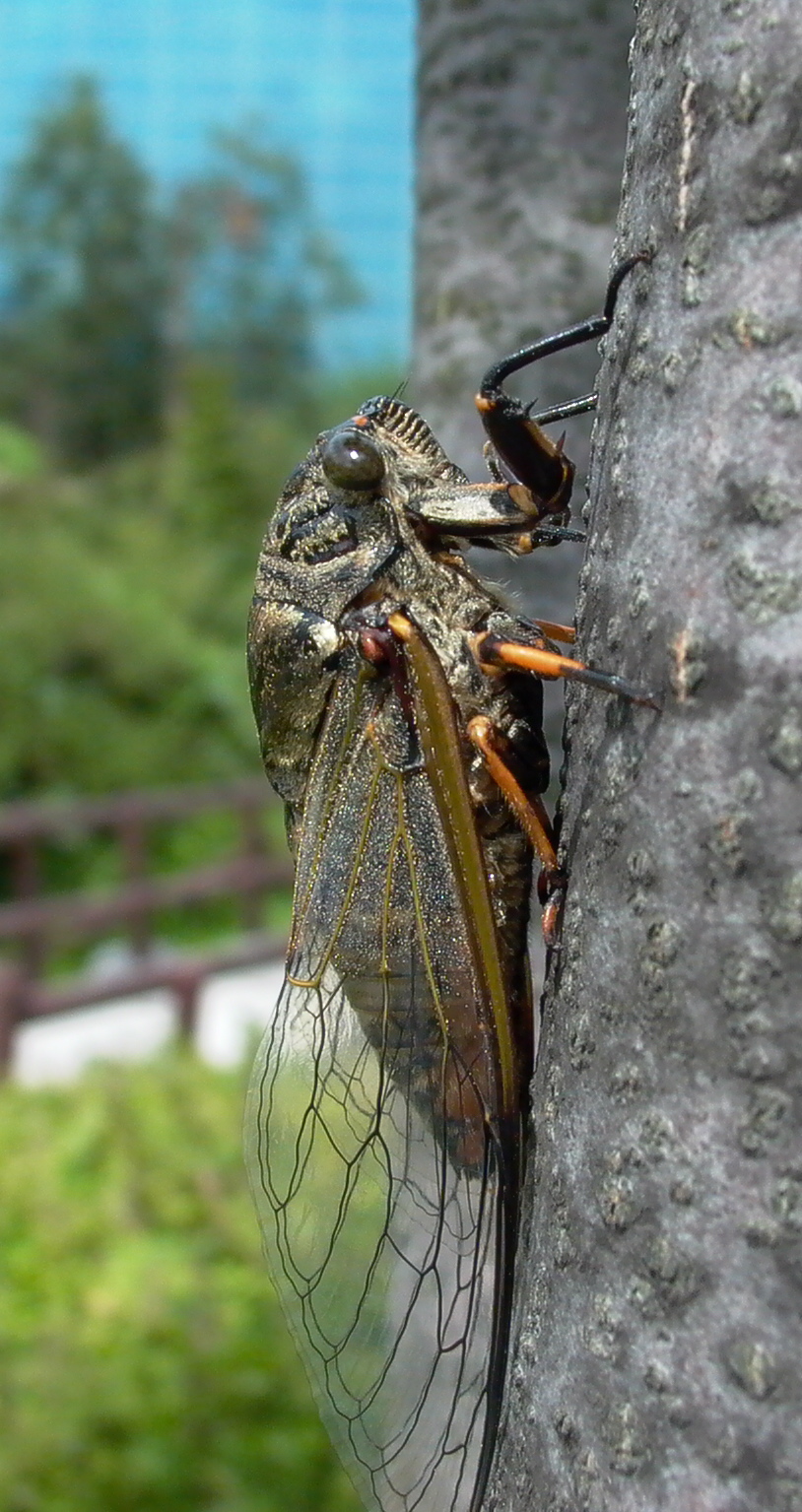
Graptopsaltria nigrofuscata is a cicada found in Japan and Korea. There are two subspecies. It is also known as Abura-zemi.
Photo by Osamu Hikino:
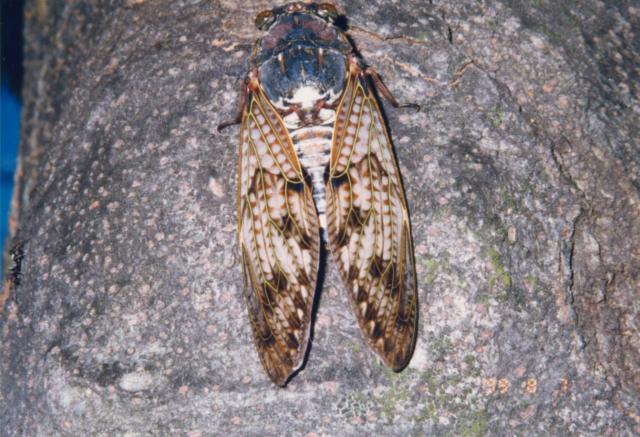
Scientific classification:
Family: Cicadidae
Subfamily: Cicadinae
Tribe: Polyneurini
SubTribe: Polyneurina
Genus: Graptopsaltria
Species:
For more information about this cicada, visit Cicadae in Japan.
According to iNaturalist observations this cicada is found in July and August.
Species name information comes from Allen Sanborn’s Catalogue of the Cicadoidea (Hemiptera: Auchenorrhyncha).
Cryptotympana aquila is a cicada found in Indonesia, Malaysia, Brunei, Thailand, and likely adjacent nations.
Photo by Michel Chantraine:
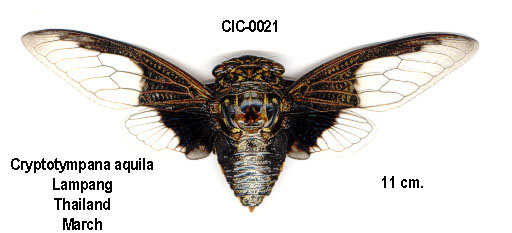
This description comes from A Monograph of Oriental Cicadas by W. L. Distant. 1889-1892. Read it on the Biodiversity Heritage Library website.
Male: Body above black; eyes ochraceous; ocelli luteous. Pronotum with some indistinct discal markings and the posterior margin pale castaneous. Mesonotum with a central triangular linear fascia, on each side of which is an irregular and inwardly notched fascia, and the basal cruciform elevation, pale castaneous. Abdomen black, the lateral margins fringed with pale castaneous pile. Body beneath very pale castaneous; the face, anterior margin of the head between face and eyes, and basal abdominal patch, black. Anterior legs black, the femera streaked with pale castaneous; intermediate legs with the femora black streaked with pale castaneous, the tibis pale castaneous with their bases and apices black; posterior legs pale castaneous, the bases and apices of femora and tibiae black.
Tegmina and wing pale hyaline; tegmina with the venation and the costal membrane pale castaneous, the extreme basal margin of the last black; the basal third (excluding venation) and the subcostal area to apex, blackish; wings with about basal half obliquely black.
The body is robust but moderately elongate; the opercula do not overlap at their basal margins, and at a short distance from base become widely divergent and narrowed to apices, their outer margins slightly concavely sinuate and in length, they extend a little beyond the middle of the abdomen.
Long. excl. tegm. Male, 40 to 45 millim. Exp. tegm. 115 to 120 millim.
Scientific classification:
Family: Cicadidae
Subfamily: Cicadinae
Tribe: Cryptotympanini
SubTribe: Cryptotympanina
Genus: Cryptotympana
Species: Cryptotympana aquila (Walker, 1850)
Cryptotympana atrata (Fabricius, 1775) is a cicada found in China and Korea.
Scientific classification:
Family: Cicadidae
Subfamily: Cicadinae
Tribe: Cryptotympanini
SubTribe: Cryptotympanina
Genus: Cryptotympana
Species: Cryptotympana atrata (Fabricius, 1775)
Cryptotympana atrata was formerly named Cryptotympana sinensis.
.
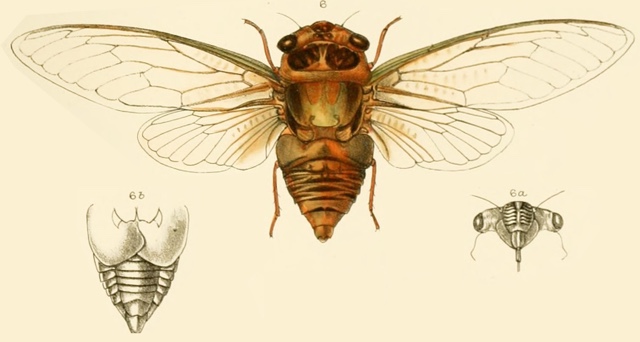

Photo by Jon Allen in Yeouido park in Seoul in South Korea.
(Cryptotympana sinensis) species description from A Monograph of Oriental Cicadas by W.L. Distant:
[Male] Head ochraceous; front with the margins (but not meeting at apex) broadly castaneous; eyes olivaceous; ocelli reddish-ochraceous, with their surrounding area castaneous. Pronotum castaneous, the margins and a central fascia, which is much widened and ampliated at base, ochraceous. Mesonotum ochraceous, with two large obconical castaneous spots near each lateral margin and two large, central, very obscure obconical spots, which are only visible by their slightly darker margins; basal cruciform elevation pale olivaceous. Abdomen above ochraceous, the posterior segmental margins castaneous. Body beneath and legs ochraceous; face with the lateral carinae castaneous; apices of the tibiae and tarsi castaneous.
Tegmina pale hyaline, the venation ochraceous, the costal membrane pale greenish, and the basal third of the tegminal area tinged with pale ochraceous. Wings pale hyaline, the venation ochraceous, and the base narrowly tinged with pale ochraceous.
The face is tumid, the lateral carina robust and slightly waved; the rostrum extends to the intermediate coxae; the opercula are somewhat short, with their lateral margins slightly concave and their posterior margins oblique, they overlap at the center, and their apices extend to about the second abdominal segment.
Long. excl. tegm. [male] 40 millim. Exp. tegm. 118 millim.
Ayesha serva (Walker, 1850) is a cicada found in the Philipines and on Borneo (Brunei, Malaysia and Indonesia), and Korea?
This one is interesting. Back when Distant wrote the Homoptera. Fam. Cicadidae, Subfam, Cicadinae. found in Genera Insectorum, 1932, there were two cicada species: Ayesha serva, found in the Philipines and Borneo, and Ayesha spathulata found in Korea. Today both species are unified under Ayesha serva. There’s a large distance between Korea and Borneo, so this makes me wonder, was A. serva actually ever in Korea, or are they two different cicadas?
Scientific classification:
Family: Cicadidae
Subfamily: Cicadinae
Tribe: Dundubiini
SubTribe: Dundubiina
Genus: Ayesha
Species: Ayesha serva (Walker, 1850)
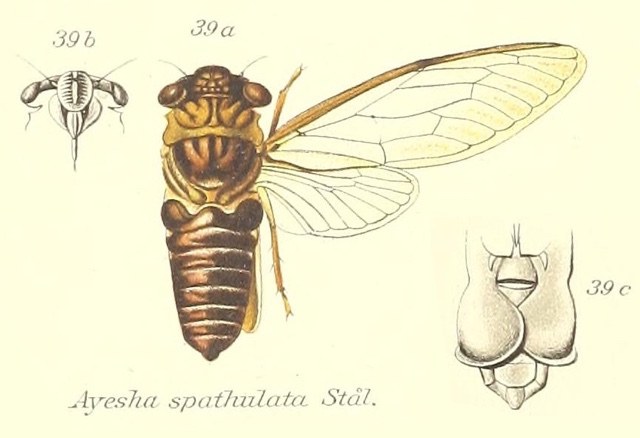
The image says Ayesha spathulata, but the newer name of this cicada is Ayesha serva.
Ayesha genus description by W. L. Distant from Genera Insectorum, 1913:
Characters. — Head (including eyes) as wide or a little wider than base of mesonotum, much shorter than breadth between eyes, lateral margins obliquely continuous to face or very slightly sinuate, eyes large and oblique; pronotum shorter than mesonotum, its lateral margins angulated anteriorly; mesonotum moderately convexly tumid; abdomen short, not longer than space between apex of head and base of cruciform elevation; tympanal coverings about as long as broad; rostrum reaching the intermediate coxae; opercula in male long, about twice as broad at apex as at base, inner .margins concave, widening to basal area, outer margins sinuate near centre, their apices broad overlapping;tegmina and wings hyaline, greatest width of tegmina about one third their length.
The illustration and genus description comes from the journal Genera Insectorum, and a specific article from 1913 by W. L. Distant titled Homoptera. Fam. Cicadidae, Subfam, Cicadinae. Read it on the Biodiversity Heritage Library website.
Current species name verified using Allen Sanborn’s Catalogue of the Cicadoidea (Hemiptera: Auchenorrhyncha).
Many species shown on this page are not endemic to a single country. Typically if a cicada can be found in one country in Indo-China (Cambodia, Laos, Malaysia, Myanmar, Singapore, Thailand, Vietnam), it will be found in many others, as well as southern China.
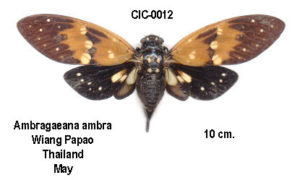
Ambragaeana ambra Chou & Yao, 1985. Photo by Michel Chantraine.
Ambragaeana ambra is found in Indo-China and China.
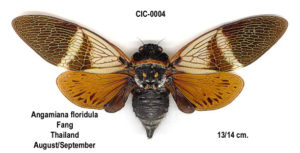
Angamiana floridula Distant, 1904
Angamiana floridula is found in Indo-China and China.
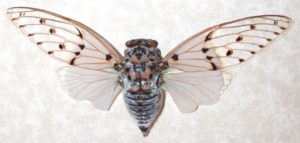
Ayuthia spectabile Distant, 1919.
Ayuthia spectabile is found in Indo-China and China.
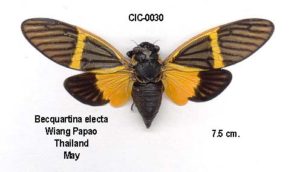
Becquartina electa (Jacobi, 1902) from Thailand. Photo by Michel Chantraine.
Becquartina electa is found in Indo-China and China.
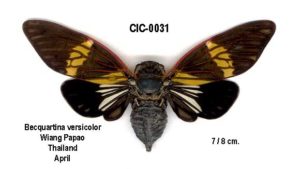
Becquartina versicolor Boulard, 2005 Thailand. Photo by Michel Chantraine.
Becquartina versicolor is found primarily in Thailand, but I imagine it can be found in adjacent nations as well.
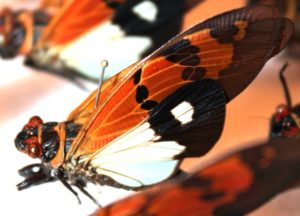
Callogaeana festiva festiva (Fabricius, 1803). Formerly Gaeana festiva.
Callogaeana festiva festiva is found in Indo-China and China.
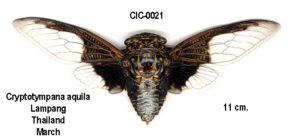
Cryptotympana aquila (Walker, 1850) from Thailand. Photo by Michel Chantraine.
Cryptotympana aquila has a huge range from Korea south to Indo-China, as well as, Borneo, Sumatra and Brunei.
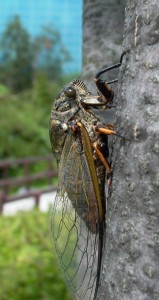
Female Cryptotympana atrata (Fabricius, 1775) from Korea. Photo by Jon Allen.
Cryptotympana atrata has a large range from Indo-China north to Korea.
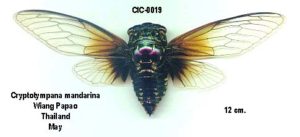
Cryptotympana mandarina Distant, 1891. Photo by Michel Chantraine.
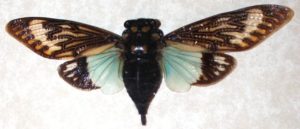
Distantalna splendida (Distant, 1878)
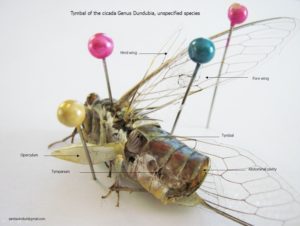
Dundubia sp. Photo by Santisuk Vibul.
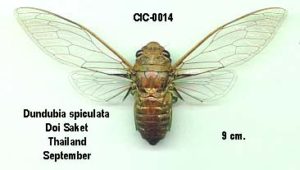
Dundubia spiculata Noualhier, 1896. Photo by Michel Chantraine.
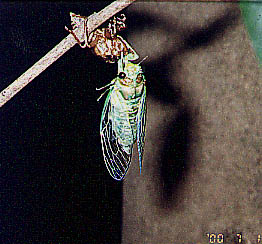
Euterpnosia chibensis. Photo by Osamu Hikino.
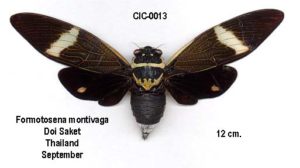
Formotosena montivaga (Distant, 1889). Photo by Michel Chantraine.
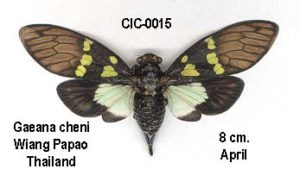
Gaeana cheni Chou & Yao, 1985. Photo by Michel Chantraine.
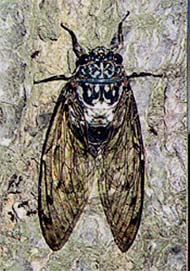 Hyalessa maculaticollis maculaticollis (de Motschulsky, 1866). Photo by Osamu Hikino.
Hyalessa maculaticollis maculaticollis (de Motschulsky, 1866). Photo by Osamu Hikino.
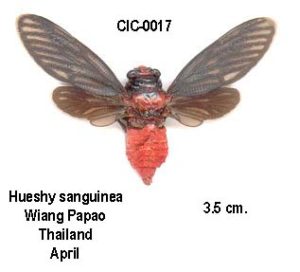
Huechys sanguinea (Degeer, 1773). Photo by Michel Chantraine.
H. sanguinea can be found throughout Asia, including China, Indo-China, India & Pakistan.
Depending on who you ask, the Genus is Lyristes or Tibicen, so I’ll mention both. Wait — not it’s Auritibicen.
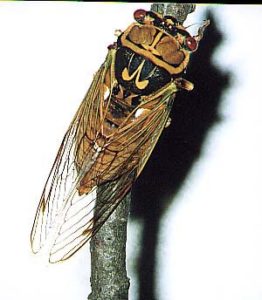
Lyristes flammatus or Tibicen flammatus (Distant, 1892)
L. flammatus aka T. flammatus (there is some dispute over the name of the genus) can be found in Japan, Korea and China.
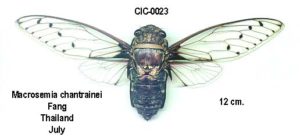
Macrosemia chantrainei Boulard, 2003. Photo by Michel Chantraine.
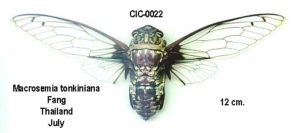
Macrosemia tonkiniana (Jacobi, 1905). Photo by Michel Chantraine.
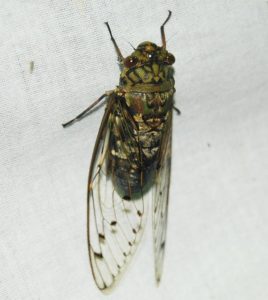
Macrosemia umbrata. Photo by Raghu Ananth.
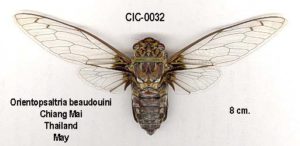
Orientopsaltria beaudouini Boulard, 2003. Photo by Michel Chantraine.
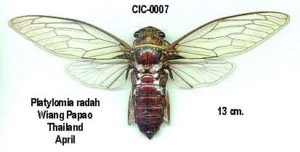
Platylomia radah (Distant, 1881). Photo by Michel Chantraine.
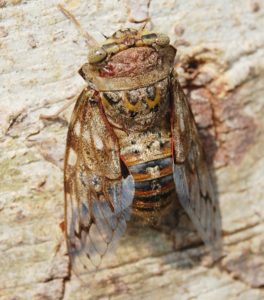
Platypleura capitata (Olivier, 1790). Photo by Raghu Ananth.
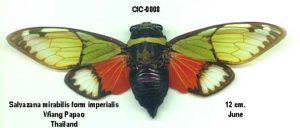
Salvazana mirabilis imperialis Distant, 1918. Photo by Michel Chantraine.
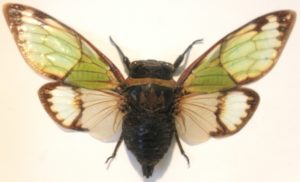
Salvazana mirabilis mirabilis Distant, 1913
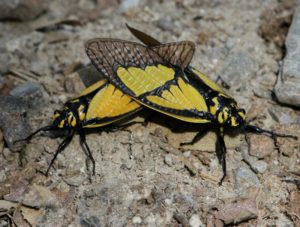
Sulphogaeana sulphurea (Westwood, 1839).

Tacua speciosa (Illger, 1980). Photo by Anonymous.

Tailanga binghami Distant, 1890. Photo by Michel Chantraine.
T. binghami is found in China and the countries of Indo-China.

Tosena albata Distant, 1878. Photo by Michel Chantraine.
Cicada species names and locations verified using The Catalogue of the Cicadoidea (Hemiptera: Auchenorrhyncha) by Allen F Sanborn.
The photo below was taken by Jon Allen in Yeouido park in Seoul in South Korea. Click the image for a huge version. Anyone know what it is?